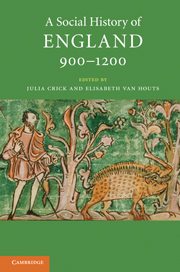Book contents
- Frontmatter
- Contents
- List of figures
- List of maps and tables
- List of contributors
- Acknowledgements
- List of abbreviations
- Map 1 England and its neighbours
- Map 2 England 900–1200
- I Introduction
- I.1 Land use and people
- I.2 Water and land
- I.3 Forest and upland
- I.4 Mineral resources
- I.5 Health and disease
- II.1 Authority and community
- II.2 Lordship and labour
- II.3 Order and justice
- II.4 War and violence
- II.5 Family, marriage, kinship
- II.6 Poor and powerless
- III.1 Towns and their hinterlands
- III.2 Commerce and markets
- III.3 Urban planning
- III.4 Urban populations and associations
- IV.1 Invasion and migration
- IV.2 Ethnicity and acculturation
- IV.3 Intermarriage
- IV.4 The Jews
- V.1 Religion and belief
- V.2 Rites of passage and pastoral care
- V.3 Saints and cults
- V.4 Public spectacle
- V.5 Textual communities (Latin)
- V.6 Textual communities (vernacular)
- VI.1 Learning and training
- VI.2 Information and its retrieval
- VI.3 Esoteric knowledge
- VI.4 Medical practice and theory
- VI.5 Subversion
- Glossary
- Time line 900–1200
- Further reading
- Index
III.2 - Commerce and markets
Published online by Cambridge University Press: 05 June 2012
- Frontmatter
- Contents
- List of figures
- List of maps and tables
- List of contributors
- Acknowledgements
- List of abbreviations
- Map 1 England and its neighbours
- Map 2 England 900–1200
- I Introduction
- I.1 Land use and people
- I.2 Water and land
- I.3 Forest and upland
- I.4 Mineral resources
- I.5 Health and disease
- II.1 Authority and community
- II.2 Lordship and labour
- II.3 Order and justice
- II.4 War and violence
- II.5 Family, marriage, kinship
- II.6 Poor and powerless
- III.1 Towns and their hinterlands
- III.2 Commerce and markets
- III.3 Urban planning
- III.4 Urban populations and associations
- IV.1 Invasion and migration
- IV.2 Ethnicity and acculturation
- IV.3 Intermarriage
- IV.4 The Jews
- V.1 Religion and belief
- V.2 Rites of passage and pastoral care
- V.3 Saints and cults
- V.4 Public spectacle
- V.5 Textual communities (Latin)
- V.6 Textual communities (vernacular)
- VI.1 Learning and training
- VI.2 Information and its retrieval
- VI.3 Esoteric knowledge
- VI.4 Medical practice and theory
- VI.5 Subversion
- Glossary
- Time line 900–1200
- Further reading
- Index
Summary
After the disasters that followed the collapse of Roman authority, trade, both international and internal, eventually grew, but its institutional infrastructure needed to be recreated. Even where towns eventually revived on old sites they operated with newly devised trading institutions and new monetary systems. During the eighth and earlier ninth centuries overseas commerce increased, especially through London, Southampton, Ipswich and York, and wider trading interests prompted currency reform as well as co-operation between the principal English monarchies. A single standard of currency established by the kings of Mercia and Wessex, together with the archbishop of Canterbury, implied a common interest in trade. But the later ninth and early tenth centuries experienced a temporary setback in parts of England as the Danish invasions of eastern England disrupted established institutions and practices. The level of international trade stagnated in the wics through which merchandise had previously passed, and the money supply diminished. Danish rulers ultimately proved no less interested than the English kings in fostering trade, but the coins they minted were of lower quality. No common standard of currency was re-established until King Edgar's new coinage of 973. The year 900 is accordingly a useful point at which to take stock of the institutional provision for trade, before proceeding to examine the subsequent revival of commerce in the Late Saxon and Anglo-Norman periods.
- Type
- Chapter
- Information
- A Social History of England, 900–1200 , pp. 179 - 187Publisher: Cambridge University PressPrint publication year: 2011



